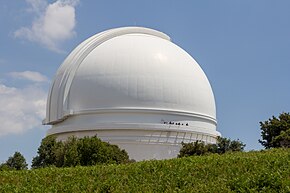
Back Telescopi Hale Catalan Palomar-Observatorium#Hale-Teleskop German Telescopio Hale Spanish تلسکوپ هیل Persian Telescopio Hale Galician Հեյլի աստղադիտարաններ Armenian Telescopio Hale Italian ヘール望遠鏡 Japanese 헤일 망원경 Korean Haletelescoop Dutch
 | |
| Alternative names | palomar |
|---|---|
| Named after | George Ellery Hale |
| Part of | Palomar Observatory |
| Location(s) | Palomar Mountain, California, United States |
| Coordinates | 33°21′23″N 116°51′54″W / 33.35628°N 116.86489°W |
| Altitude | 1,713 m (5,620 ft) |
| First light | January 26, 1949, 10:06 pm PST |
| Discovered | Caliban, Sycorax, Jupiter LI, Alcor B |
| Telescope style | optical telescope reflecting telescope |
| Diameter | 200 in (5.1 m) |
| Collecting area | 31,000 sq in (20 m2) |
| Focal length | 16.76 m (55 ft 0 in) |
| Mounting | equatorial mount |
| Website | www |
| | |
The Hale Telescope is a 200-inch (5.1 m), f/3.3 reflecting telescope at the Palomar Observatory in San Diego County, California, US, named after astronomer George Ellery Hale. With funding from the Rockefeller Foundation in 1928, he orchestrated the planning, design, and construction of the observatory, but with the project ending up taking 20 years he did not live to see its commissioning. The Hale was groundbreaking for its time, with double the diameter of the second-largest telescope, and pioneered many new technologies in telescope mount design and in the design and fabrication of its large aluminum coated "honeycomb" low thermal expansion Pyrex mirror.[1] It was completed in 1949 and is still in active use.
The Hale Telescope represented the technological limit in building large optical telescopes for over 30 years. It was the largest telescope in the world from its construction in 1949 until the Soviet BTA-6 was built in 1976, and the second largest until the construction of the Keck Observatory Keck 1 in Hawaii in 1993.
- ^ "The 200-inch Hale Telescope". www.astro.caltech.edu.
